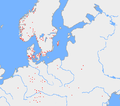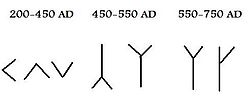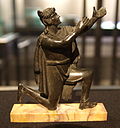symbols instead of runes. The Elder Futhark (or Fuþark), also known as the Older Futhark, Old Futhark, or Germanic Futhark, is the oldest form of the runic...
33 KB (3,832 words) - 23:13, 5 August 2024
instead of runes. The Younger Futhark, also called Scandinavian runes, is a runic alphabet and a reduced form of the Elder Futhark, with only 16 characters...
14 KB (1,401 words) - 22:13, 14 October 2024
Runic inscriptions (redirect from Alemannic Elder Futhark inscriptions)
The body of runic inscriptions falls into the three categories of Elder Futhark (some 350 items, dating to between the 2nd and 8th centuries AD), Anglo-Frisian...
22 KB (2,639 words) - 05:27, 4 February 2024
Algiz (redirect from Yr rune (Younger Futhark))
(also Elhaz) is the name conventionally given to the "z-rune" ᛉ of the Elder Futhark runic alphabet. Its transliteration is z, understood as a phoneme of...
24 KB (2,886 words) - 21:55, 10 November 2024
Jēran (section Elder Futhark)
Jeran, Jeraz, Yera) is the conventional name of the j-rune ᛃ of the Elder Futhark, from a reconstructed Common Germanic stem *jēra- meaning "harvest,...
8 KB (869 words) - 21:56, 10 November 2024
Bind rune (section Elder futhark)
under a ship on DR 220 in Sønder Kirkeby, Denmark. Examples found in Elder Futhark inscriptions include: Stacked Tiwaz runes: Kylver Stone, Seeland-II-C...
9 KB (950 words) - 14:52, 11 November 2024
as Elder Futhark, expanding to 28 characters in its older form and up to 34 characters in its younger form. In contemporary Scandinavia, the Elder Futhark...
36 KB (2,474 words) - 11:09, 1 November 2024
Othala (section Elder Futhark o-rune)
ēðel and odal, is a rune that represents the o and œ phonemes in the Elder Futhark and the Anglo-Saxon Futhorc writing systems respectively. Its name is...
21 KB (2,266 words) - 21:47, 10 November 2024
needed] Elder Futhark Sowilo rune, earlier ("Σ") variant. Elder Futhark Sowilo rune, later ("S") variant. Anglo-Saxon Sigel / Younger Futhark Sol rune...
9 KB (854 words) - 22:02, 10 November 2024
Anglo-Saxon name. The Elder Futhark shape is likely directly based on Old Italic c (, 𐌂) and on Latin C. The Younger Futhark and Anglo-Saxon Futhorc...
4 KB (209 words) - 21:55, 10 November 2024
Ansuz (rune) (section Development in Younger Futhark)
of runes. Ansuz is the conventional name given to the a-rune of the Elder Futhark, ᚨ. The name is based on Proto-Germanic *ansuz, denoting a deity belonging...
5 KB (288 words) - 21:45, 10 November 2024
ᛗ of the Elder Futhark. It is derived from the reconstructed Proto-Germanic (or Common Germanic) word for 'man', *mannaz. The Younger Futhark equivalent...
4 KB (167 words) - 22:19, 10 November 2024
second rune in all runic alphabets (futharks), i.e. Germanic Elder Futhark, Anglo-Frisian Futhark and Norse Younger Futhark. It corresponds to the letter u...
14 KB (1,190 words) - 21:54, 10 November 2024
as hægl, and, in the Younger Futhark, as ᚼ hagall. The corresponding Gothic letter is 𐌷 h, named hagl. The Elder Futhark letter has two variants, single-barred...
3 KB (188 words) - 21:57, 10 November 2024
sound p (voiceless bilabial stop) in the Elder Futhark runic alphabet. It does not appear in the Younger Futhark. It is named peorð in the Anglo-Saxon rune-poem...
5 KB (626 words) - 21:54, 10 November 2024
List of runestones (section Elder Futhark runestones)
majority of runestones date to the Viking Age. There is only a handful Elder Futhark (pre-Viking-Age) runestones (about eight, counting the transitional...
12 KB (1,325 words) - 08:00, 16 April 2024
journey" is the reconstructed Proto-Germanic name of the r- rune of the Elder Futhark ᚱ. The name is attested for the same rune in all three rune poems, Old...
2 KB (121 words) - 21:56, 10 November 2024
more accurately Ingvaeones, and is also the reconstructed name of the Elder Futhark rune ᛜ and Anglo-Saxon rune ᛝ, representing ŋ. Old Norse Yngvi as well...
12 KB (1,346 words) - 21:47, 10 November 2024
i, named eis. The rune is recorded in all three rune poems: Elder Futhark Younger Futhark Rune poem Original poems and translation from the Rune Poem...
2 KB (94 words) - 21:58, 10 November 2024
the sixth century onward. The letters of the Elder Futhark are arranged in an order called the futhark, so named after its first six characters. The...
164 KB (20,237 words) - 21:00, 21 November 2024
Gothic alphabet 𐌳 d is called dags. This rune is also part of the Elder Futhark, with a reconstructed Proto-Germanic name *dagaz. Its "butterfly" shape...
3 KB (227 words) - 22:01, 10 November 2024
intended for the representation of text written in Elder Futhark, Anglo-Saxon runes, Younger Futhark (both in the long-branch and short-twig variants)...
30 KB (1,030 words) - 16:28, 26 July 2024
Iceland, where it survives. The letter originated from the rune ᚦ in the Elder Futhark and was called thorn in the Anglo-Saxon and thorn or thurs in the Scandinavian...
16 KB (1,486 words) - 11:09, 10 November 2024
reconstruct the Elder Futhark rune's Proto-Germanic name. Assuming that the Scandinavian name þurs is the most plausible reflex of the Elder Futhark name, a Common...
5 KB (436 words) - 21:58, 10 November 2024
likely give their name to the A-rune, attested in Elder Futhark, Anglo-Saxon Futhorc and Younger Futhark. The modern English term "Æsir" is derived from...
36 KB (3,992 words) - 03:15, 2 November 2024
runes at the end of an Elder Futhark inscription. From 500 AD, a Scandinavian C-bracteate (Seeland-II-C) features an Elder Futhark inscription ending with...
11 KB (963 words) - 21:59, 10 November 2024
Kylver Stone (category Elder Futhark inscriptions)
about 400 AD. It is notable for its listing of each of the runes in the Elder Futhark. The Kylver stone was found during the excavation of a cemetery near...
6 KB (819 words) - 14:45, 31 May 2024
alphabets, and its shape is also continued into the Algiz rune <ᛉ> of the Elder Futhark. Psi, or its Arcadian variant or was adopted in the Latin alphabet in...
7 KB (860 words) - 01:34, 7 November 2024
beorc ⟨ᛒ⟩, meaning "birch". Beorc dates to at least the 2nd-century Elder Futhark, which is now thought to have derived from the Old Italic alphabets'...
17 KB (1,388 words) - 07:18, 22 October 2024













